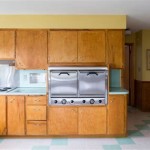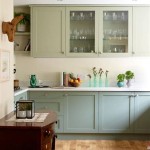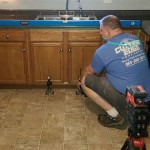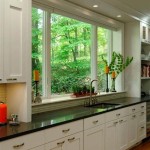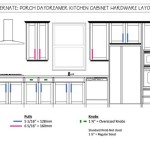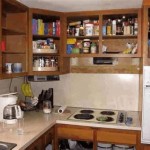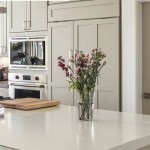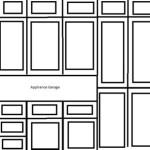Modern Contemporary Kitchen Design Ideas
The modern contemporary kitchen represents a confluence of styles, blending the sleek lines of modernism with the warmth and accessibility of contemporary design. This aesthetic prioritizes functionality, clean aesthetics, and the incorporation of innovative materials and technology. Crafting a kitchen that embodies this style requires careful consideration of layout, materials, color palettes, and appliances. The following explores various design ideas to inspire a modern contemporary kitchen transformation.
Open Layout and Spatial Flow
A defining characteristic of modern contemporary kitchens is the emphasis on open layouts. Traditional kitchens often confine the cooking space, whereas modern designs seek to integrate the kitchen seamlessly with living and dining areas. This open floor plan facilitates social interaction and creates a sense of spaciousness.
Achieving this open flow often involves removing dividing walls or replacing them with partial partitions, such as kitchen islands or peninsulas. These features not only delineate the kitchen space but also provide additional countertop space for food preparation, serving, and casual dining. The strategic placement of these elements is crucial to maintaining a balanced and functional layout. Consideration must be given to traffic flow, ensuring individuals can move freely between the kitchen and adjacent living areas without obstruction.
The use of consistent flooring throughout the open space helps to further unify the kitchen with surrounding areas. Opting for materials like hardwood, tile, or polished concrete creates a seamless transition and reinforces the feeling of continuity. Lighting design also plays a vital role. Recessed lighting, pendant lights above islands, and under-cabinet lighting can effectively illuminate the space while maintaining a sleek and uncluttered aesthetic.
Furthermore, incorporating large windows or glass doors can enhance the sense of openness by bringing natural light into the kitchen. This not only brightens the space but also connects it visually with the outdoors. Strategic window placement can also provide views of gardens or other outdoor features, contributing to a more relaxed and inviting atmosphere.
Minimalist Cabinetry and Sleek Surfaces
Cabinetry in a modern contemporary kitchen typically embraces minimalist design principles. Clean lines, flat-panel doors, and the absence of ornate detailing are hallmarks of this aesthetic. These design choices contribute to a streamlined and uncluttered appearance, reflecting the overarching emphasis on simplicity.
Common materials for modern contemporary cabinets include wood veneer, laminate, and painted surfaces. Choosing high-quality materials ensures durability and longevity, while also contributing to the overall visual appeal of the kitchen. Color selection is also critical. Neutral tones like white, gray, and beige are popular choices, as they create a sense of calm and sophistication. These colors also provide a versatile backdrop for incorporating pops of color through accessories and décor.
Hardware should be kept to a minimum and should complement the clean lines of the cabinets. Sleek, stainless steel pulls or push-to-open mechanisms are often preferred. The absence of visible hardware can further enhance the minimalist aesthetic. For countertops, materials like quartz, granite, and stainless steel are popular choices. These materials are not only durable and easy to maintain but also offer a sleek and modern look.
Backsplashes often feature simple designs, such as subway tiles, glass mosaics, or large-format slabs. These elements provide a subtle visual interest without overwhelming the space. The use of a single material or color for the backsplash can create a cohesive and unified look. Integrated sinks and hidden appliances can also contribute to the streamlined appearance of the kitchen.
Integrated Technology and Smart Appliances
Modern contemporary kitchens are often equipped with integrated technology and smart appliances. These features enhance functionality and convenience, while also contributing to a more sophisticated and cutting-edge design. Smart appliances, such as refrigerators with built-in touchscreens, ovens with remote control capabilities, and dishwashers with automated cycles, are becoming increasingly common.
Integrated lighting systems allow for customized lighting control and can be programmed to adjust based on time of day or activity. Voice-activated assistants, such as Amazon Alexa or Google Assistant, can be integrated into the kitchen to control lighting, appliances, and music. These technologies can also be used to access recipes, set timers, and manage grocery lists.
Smart faucets with touchless operation or voice control can help to conserve water and improve hygiene. Under-cabinet lighting with motion sensors can provide convenient illumination for tasks and prevent energy waste. Integrated charging stations for mobile devices and other electronic gadgets can keep countertops clutter-free.
Furthermore, consider incorporating smart storage solutions, such as pull-out shelves, organizers, and automated pantry systems. These features can help to maximize space and improve organization. The use of integrated technology not only enhances the functionality of the kitchen but also contributes to a more modern and convenient lifestyle.
Emphasis on Natural Light and Ventilation
Natural light is a crucial element in modern contemporary kitchen design. Maximizing the amount of natural light entering the space can significantly enhance its ambiance and functionality. Large windows, skylights, and glass doors are effective ways to bring natural light into the kitchen.
Strategic window placement can also help to minimize the need for artificial lighting during the day. Consider the orientation of the kitchen when planning window placement to ensure optimal sunlight exposure. Light-colored walls and countertops can help to reflect natural light throughout the space, making it feel brighter and more open.
Adequate ventilation is equally important. A powerful range hood is essential for removing cooking odors and smoke from the kitchen. Choose a range hood that complements the overall design aesthetic and provides sufficient ventilation based on the size of the kitchen and the type of cooking that will be done.
Consider incorporating operable windows or skylights to provide natural ventilation. These can be opened to allow fresh air to circulate through the kitchen, helping to improve air quality and reduce humidity. Proper ventilation can also help to prevent the build-up of mold and mildew, creating a healthier and more comfortable environment.
Color Palette and Material Selection
The color palette in a modern contemporary kitchen often revolves around neutral tones, such as white, gray, beige, and black. These colors provide a versatile backdrop for incorporating pops of color through accessories, artwork, or accent walls. Monochromatic color schemes, which use different shades of the same color, can also create a sophisticated and cohesive look.
The selection of materials is also crucial. Natural materials, such as wood, stone, and glass, are often incorporated to add warmth and texture to the space. Engineered materials, such as quartz, stainless steel, and laminate, offer durability and ease of maintenance.
Mixing different materials can create visual interest and add depth to the design. For example, pairing wood cabinets with a granite countertop and a stainless steel backsplash can create a balanced and sophisticated look. Textural contrasts, such as combining smooth surfaces with rough textures, can also add visual appeal.
Consider using metallic accents, such as stainless steel, brushed nickel, or copper, to add a touch of glamour to the kitchen. These accents can be incorporated through hardware, lighting fixtures, or decorative elements. When selecting colors and materials, consider the overall style of the home and how the kitchen will integrate with the surrounding spaces.
Incorporating Sustainable and Eco-Friendly Elements
Sustainable design principles are increasingly important in modern contemporary kitchens. Incorporating eco-friendly materials and energy-efficient appliances can help to reduce the environmental impact of the kitchen.
Consider using recycled materials for countertops, cabinets, and flooring. Bamboo, reclaimed wood, and recycled glass are all sustainable options that can add visual interest to the kitchen. Choose water-efficient faucets and appliances to conserve water. Install LED lighting to reduce energy consumption.
Opt for low-VOC paints and finishes to improve indoor air quality. Consider incorporating a composting system to reduce food waste. By incorporating sustainable and eco-friendly elements into the kitchen design, one can create a space that is not only beautiful and functional but also environmentally responsible.
Statement Lighting and Fixtures
Lighting plays a pivotal role in defining the ambiance of a modern contemporary kitchen. Beyond mere illumination, fixtures can serve as focal points, contributing significantly to the overall aesthetic. Pendant lights suspended above kitchen islands or dining areas are popular choices, offering both task lighting and a visual statement.
Consider selecting fixtures that complement the kitchen's color palette and material choices. Metallic finishes like brushed brass or matte black can provide a touch of sophistication, while geometric shapes and clean lines reinforce the modern aesthetic. Dimmable lighting allows for customized illumination, enabling adjustment of the mood and intensity to suit various activities.
Under-cabinet lighting is essential for providing task lighting for food preparation areas, while recessed lighting can offer general ambient illumination. Strategic placement of lighting can highlight architectural features or showcase decorative elements. The integration of smart lighting systems allows for automated control and energy efficiency, further enhancing the functionality of the kitchen.
Personalization and Unique Details
While modern contemporary design emphasizes clean lines and minimalism, there is still ample opportunity to incorporate personal touches and unique details. Adding artwork, plants, or decorative objects can personalize the space and reflect one's individual style.
Consider incorporating open shelving to display favorite cookbooks, ceramics, or other decorative items. A custom-designed backsplash can add a unique focal point to the kitchen. The integration of smart storage solutions can also personalize the kitchen to meet individual needs and preferences.
Selecting hardware, lighting fixtures, and accessories that reflect personal taste can further enhance the individual character of the kitchen. The key is to strike a balance between minimalism and personalization, creating a space that is both stylish and functional.

58 Best Contemporary Kitchen Design Ideas Modern Cabinets Interior Room

43 Contemporary Kitchens Kitchen Design Ideas

50 Luxury Modern Kitchen Design Ideas That Will Inspire You

30 Modern Kitchens We Love Kitchen Design Ideas

Modern Kitchen Ideas Oppolia

50 Luxury Modern Kitchen Design Ideas That Will Inspire You

24 Classic Contemporary Style Kichen Ideas And Designs Adria

16 Modern Kitchen Design Ideas For Your Home Designcafe

20 Top Kitchen Design Ideas That Will Inspire You Oppein

67 Best Modern Kitchen Design Ideas For Contemporary Homes Cabinet Cabinets Layout Wood
Related Posts

